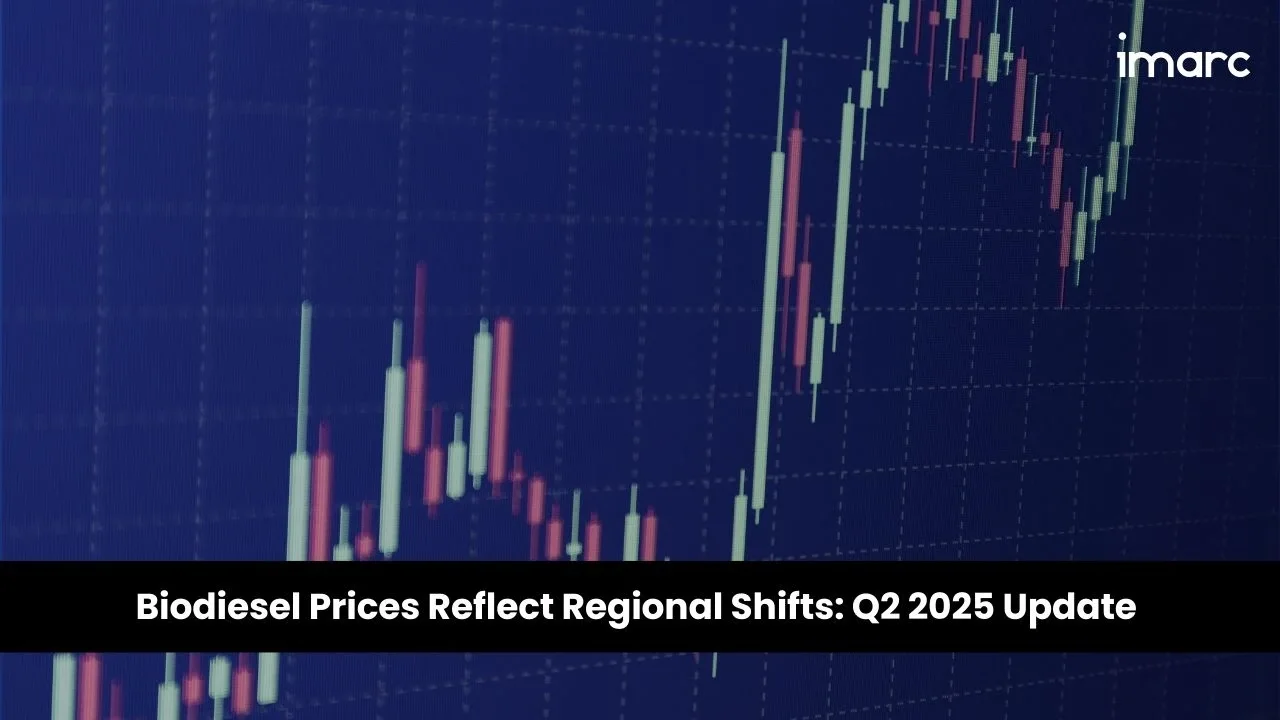Biodiesel Prices Reflect Regional Shifts: Q2 2025 Update
11-Jul-2025
The biodiesel market is experiencing notable fluctuations in pricing driven by a mix of geopolitical factors, supply chain disruptions, and evolving regulatory frameworks. IMARC Group’s latest report, Biodiesel Price Trend, Index and Forecast Data Report 2025 Edition, offers a deep dive into the updated Q2 2025 pricing trends, providing stakeholders with vital information on biodiesel prices, trends, and demand projections. The analysis highlights key regions, including North America, Europe, and Asia Pacific, shaping the current dynamics of the biodiesel market, with unique trends in each region dictating price fluctuations and market strategies.
Q2 2025 Biodiesel Prices:
- USA: USD 1641/MT
- China: USD 1407/MT
- Netherlands: USD 1547/MT
- Thailand: USD 2030/MT
- Norway: USD 1700/MT
To access real-time prices Request Sample
The current biodiesel prices underscore the material’s critical role in the renewable energy and transportation sectors, with growing demand for cleaner fuel alternatives and supply chain dynamics, contributing to the overall global price trends.
Key Regional Price Trends and Market Drivers:
United States
The biodiesel prices in the USA during Q2 2025 reached USD 1641/MT. These prices were influenced by fluctuating feedstock availability, particularly soybean oil and used cooking oil, which was impacted by crop forecasts and waste collection variability. Regional supply was also affected by refinery maintenance and transportation costs, with demand supported by Renewable Fuel Standard (RFS) compliance.
China
In Q2 2025, China saw biodiesel prices at USD 1407/MT. Prices were influenced by inconsistent access to waste-based feedstocks, particularly due to environmental controls on used oil collection. The domestic production was further challenged by rising utility costs, and demand remained steady, especially in the transportation and industrial heating sectors.
Netherlands
With prices reaching USD 1547/MT in Q2 2025, the Netherlands’ market was driven by strong demand due to European Union sustainability goals and blending mandates. Feedstock availability, especially for waste oils and animal fats, remained tight amid regional competition, while compliance costs under the Renewable Energy Directive contributed to price adjustments.
Thailand
Thailand's biodiesel prices in Q2 2025 stood at USD 2030/MT. The market was affected by fluctuations in palm oil supply due to seasonal yield variations and adverse weather conditions. Government interventions in the form of blending mandates and price control mechanisms contributed to price stability, while the transportation sector’s demand remained consistent.
Norway
In Norway, biodiesel prices reached USD 1700/MT in Q2 2025. The market was shaped by sustained demand under national biofuel blending mandates, especially with advanced biofuels. Limited domestic feedstock production led to reliance on imports, creating exposure to currency fluctuations and freight rate changes.
Biodiesel Industry Overview:
The global biodiesel market reached a value of USD 46.1 Billion in 2024 and is projected to reach USD 63.4 Billion by 2033, expanding at a CAGR of 3.61% during 2025-2033. This growth is primarily driven by increasing global efforts to reduce carbon emissions and transition towards low-carbon economies. Biodiesel, a renewable and cleaner-burning fuel, plays a crucial role in meeting sustainability goals, aligning with global initiatives like the Paris Agreement, and serving as a vital alternative to conventional fossil fuels.
Key drivers contributing to the market include supportive government policies, blending mandates, and tax incentives, all of which are enhancing the economic viability of biodiesel production. Additionally, the diversification of feedstock sources, such as waste oils, animal fats, and algae, alongside technological advancements in production processes, is further bolstering the market. As the automotive sector expands its use of biodiesel, especially in commercial vehicles and public transportation, demand is expected to remain strong, positioning biodiesel as a critical component in the future of sustainable energy.
Recent Market Trends and Industry Analysis:
Biodiesel plays a crucial role in the renewable energy sector, providing a sustainable alternative to petroleum-based fuels. Its ability to reduce greenhouse gas emissions and reliance on fossil fuels makes it an essential component of the global transition toward cleaner energy sources. Biodiesel is widely used in transportation, especially in commercial fleets, agriculture, and heavy-duty vehicles, where its renewable nature supports sustainability goals while maintaining performance standards comparable to conventional diesel.
In addition to transportation, the agriculture and waste management industries are major consumers of biodiesel, producing it from vegetable oils, animal fats, and recycled waste oils. This eco-friendly fuel is also pivotal in reducing air pollutants, such as sulfur dioxide and particulate matter, improving air quality. As governments around the world tighten emissions regulations and incentivize green energy solutions, the demand for biodiesel continues to grow, providing a cleaner and more environmentally responsible fuel alternative across multiple industries.
Strategic Forecasting and Analysis:
IMARC’s report incorporates forecasting models that project near-term price movements based on evolving trade policies, raw material supply, and technological trends. These tools enable businesses to mitigate risk, enhance sourcing strategies, and support long-term planning.
Key Features of the Report:
- Price Charts and Historical Data
- FOB and CIF Spot Pricing
- Regional Demand-Supply Assessments
- Port-Level Price Analysis
- Sector-Specific Demand and Supply Insights

_11zon.webp)
.webp)
_11zon-(1).webp)




.webp)




.webp)












